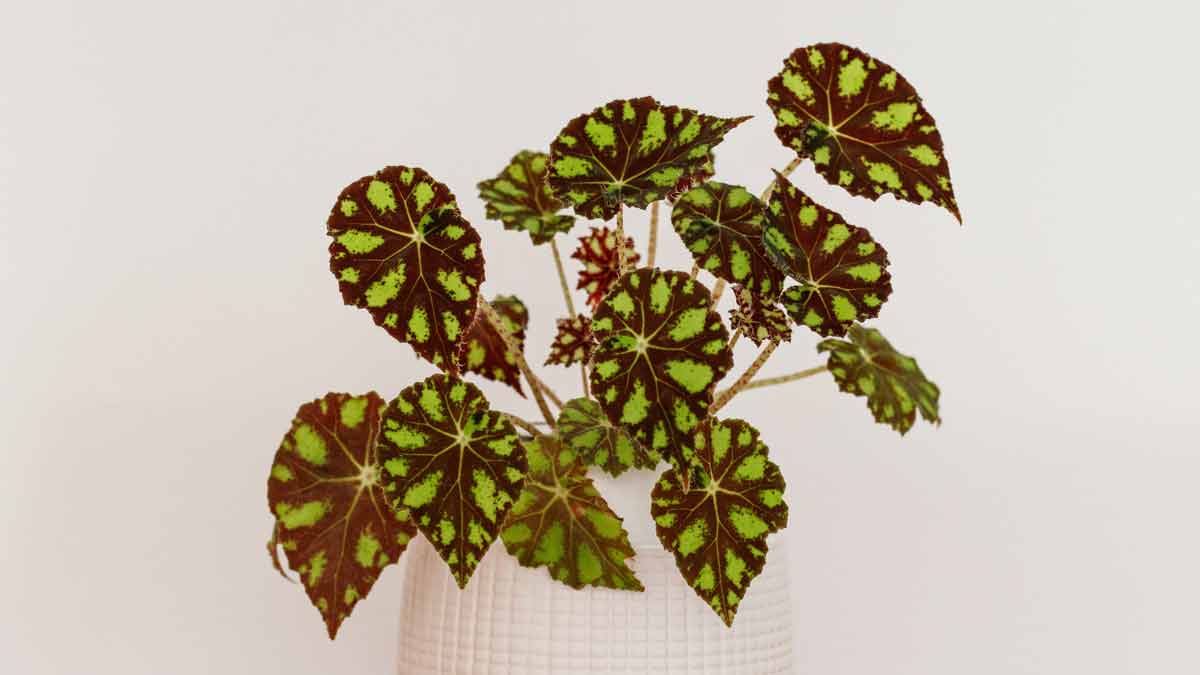To keep begonias healthy, ensure the soil is not too dry or saturated. Water every 2-4 days or more frequently during hot weather. Check the top layer of soil for dryness and water deeply. Avoid letting the soil dry out completely—water less frequently during colder weather.
Caring for Begonia plants can be a rewarding experience, as these beautiful flowering houseplants bring color and vibrancy to your home.
One critical aspect of Begonia care is understanding the proper watering routine.
With various factors affecting when and how often you should water your Begonias, it’s important to know the specifics to maintain healthy, flourishing plants.
Factors To Consider When Watering Begonia Plants
To ensure the healthy growth of your begonia plants, it’s crucial to water them appropriately.
Several factors can impact how often and how much water your begonias need, including the climate, soil type, pot size, light exposure, humidity, and the variety of begonia plants you have.
Here we’ll explore these key factors to help you determine the best watering practices for your begonia plants.
Climate
Climate plays a significant role in determining how often to water your begonia plants.
In warmer climates, where temperatures are higher and direct sunlight is more abundant, the soil dries out quickly, necessitating more frequent watering to keep the root system hydrated.
On the other hand, cooler climates with moderate temperatures will cause the soil to retain its moisture for more extended periods.
This means that Begonia owners living in regions such as Seattle or San Francisco should reduce their watering frequency accordingly.
It’s important to monitor the climate conditions within your geographical location and where your plant is placed within your home.
For instance, consider factors like proximity to air conditioning vents or radiators affecting indoor humidity levels and how often you need to water your plants.
Soil Type
Knowing the soil type is crucial in determining how often to water your begonia plants.
A well-draining, porous soil promotes healthy root growth. It prevents issues such as root rot resulting from consistently damp conditions.
For example, if you’re growing Tuberous Begonias, they prefer a more loamy soil mixture with some added organic matter like compost or well-rotted manure.
Rex Begonias and Angel Wing Begonias thrive better in potting mixes designed for indoor plants, providing good drainage and sufficient nutrients.
Humidity
Humidity plays a crucial role in determining how often to water begonia plants, as these beautiful flowering houseplants thrive in environments with higher humidity levels.
To maintain the ideal humidity for your specific type of Begonia plant and prevent issues such as powdery mildew or leaf drop, consider placing a humidifier near the plant or using a tray filled with pebbles and water underneath the pot.
This will create a microclimate that helps retain moisture without causing root rot from soggy soil.
Type Of Begonia Plant
Begonia plants come in different types, each with its unique care needs.
For instance, the Rex Begonia thrives under high humidity and indirect light. In contrast, the Wax Begonia prefers direct sunlight and well-draining soil.
The Polka Dot Begonia is known for its striking foliage that requires bright indirect light to grow lushly.
Tuberous Begonias are commonly grown as bedding plants due to their stunning blooms that require frequent watering and light fertilization.
Pot Size
Pot size is also important in how often you should water your Begonia plants.
The larger the pot, the less frequently it needs to be watered.
This is because there is more soil in a larger pot which can hold more moisture than a smaller one that dries out quickly.
For example, if you have a small pot with Rex Begonia, it may need watering every two days.
In comparison, a bigger pot with Polka Dot Begonia could go up to five days without water.
Sunlight Exposure
Sunlight exposure is an essential factor to consider when watering begonia plants.
Different types of begonias have different sunlight preferences, which can affect their watering needs.
For example, Rex Begonias prefer bright indirect light or dappled shade. At the same time, Wax Begonias do well in direct sun or partial shade.
Understanding your plant’s specific sunlight requirements and adjusting your watering schedule accordingly is essential.
If your plant gets too much sun, it may need more frequent watering as the soil will dry out faster.
Conversely, if your plant doesn’t get enough sun, you’ll want to be careful not to overwater it as the soil may stay damp for long periods.
Signs Of Overwatered Begonia Plants
Overwatering Begonia plants can lead to several signs of stress and damage.
These signs may include yellowing leaves, wilting, brown spots on the leaves, and the development of fungal growth on the soil or leaves.
Monitoring the watering frequency and quantity is essential to maintain the plant’s health and prevent overwatering.
Yellowing Leaves
Yellowing leaves on Begonia plants often indicate overwatering or allowing the soil to become too soggy.
When the roots sit in water for prolonged periods, they can start to rot, which leads to yellowing and wilting of the leaves.
This is especially common when Begonias are grown in pots without proper drainage holes or if they receive excess water from rainfall or irrigation.
Another cause of yellowing leaves on your Begonia plant could be excessive exposure to direct sunlight.
The harsh rays can damage foliage and even burn them, causing discoloration and patches of brown spots.
If you notice such symptoms, move your plant away from direct sunlight into a spot with bright indirect light.
Wilting Leaves
Wilting leaves are a common sign of overwatering and underwatering in Begonia plants.
Here are a few things to keep in mind when you notice your Begonia leaves start wilting:
- Check the soil moisture: It may be time to water your plant if the soil is dry. However, if the soil is still moist, hold off on watering for a few more days.
- Assess drainage: If the soil is too wet and doesn’t have proper drainage, this can cause wilting leaves as well. Make sure your pot has drainage holes and that excess water can escape.
- Consider humidity levels: Begonias prefer high humidity levels, so if the air in your home is too dry, this can also cause wilting leaves. Consider using a humidifier or misting your plant regularly to increase humidity.
- Check for pests or diseases: Wilting leaves can also be a sign of pests or diseases affecting your begonia plant. Inspect it closely for any signs of damage or illness.
Keeping an eye on your Begonia’s leaves and adjusting watering accordingly can help prevent wilting and ensure your plant stays healthy and thriving.
Brown Spots On The Leaves
Brown spots on Begonia leaves can be a telltale sign of overwatering.
When the soil is constantly moist or soggy, it creates an ideal environment for fungi and bacteria to thrive.
These microorganisms can cause brown spots on the leaves, which may eventually lead to leaf drop if not treated promptly.
To prevent this, it’s essential to regulate watering frequency and avoid excess moisture in the soil.
Ensure the pot has proper drainage holes to allow excess water to escape. Use a well-draining potting mix that retains moisture but doesn’t hold onto it excessively long.
Fungal Growth On The Soil Or Leaves
Fungal growth on the soil or leaves of Begonia plants can result from overwatering and high humidity.
This can lead to various problems and ultimately harm the plant’s health.
Here are some important facts to keep in mind to avoid fungal growth on your begonia plants:
- Overwatering can create a damp environment that encourages fungal growth.
- Powdery mildew is a common fungal disease found on begonia plants.
- Excess water can also cause root rot, extremely damaging to the plant.
- To prevent fungal growth, ensure proper drainage and not directly water the leaves.
- Treat any signs of fungal growth, such as white powdery spots or leaf discoloration immediately with appropriate fungicides.
- Fertilizing regularly with a balanced fertilizer can also help prevent fungal infections and promote healthy plant growth.
Signs Of Underwatered Begonia Plants
If you’re a plant parent, keeping a close eye on your begonia plants is essential.
Underwatering can cause significant damage to your Begonia’s health, and recognizing the signs early is crucial.
Wilting leaves, dry soil, crispy or brown edges on leaves, and leaf drop indicate that your Begonia is not getting enough water.
By identifying these signs, you can take steps to rehydrate your plant and restore it to optimal health.
Wilting Leaves
Wilting leaves indicate that your Begonia plant is not receiving enough water.
Here are some things to look for:
- Dry soil: If the soil around your Begonia roots is dry to the touch, it may need watering.
- Crispy or brown edges on the leaves: This can be a sign of underwatering and overwatering. Check the soil moisture level to determine which issue is the culprit.
- Leaf drop: When plants do not receive enough water, they may begin dropping their leaves to conserve what little water they have left.
- Wilting stems: Begonias with wilting stems can signify too much or too little water. Checking the soil moisture will help determine which problem it is.
Dry Soil
If you notice your Begonia plant’s soil is dry, it may be a sign of underwatering.
Dry soil can cause the leaves to become crispy or develop brown edges, possibly leading to leaf drop.
To ensure your Begonia plant stays healthy and properly hydrated, check the soil regularly by sticking your finger about an inch into the topsoil.
If it feels dry, it’s time to water your plant.
Another trick is lifting the pot – if it feels light compared to when it was last watered, watering is necessary.
Crispy Or Brown Edges On The Leaves
If you notice crispy or brown edges on your Begonia plant’s leaves, it could be a sign of underwatering, excess direct sunlight, lack of humidity, or improper watering frequency.
Here are some possible causes and solutions:
- Underwatering: If the soil is dry and the edges of the leaves are crispy or brown, your Begonia plant may not be getting enough water. Water your plant thoroughly but avoid letting it sit in standing water.
- Excess direct sunlight: Too much direct sunlight can cause the edges of Begonia leaves to turn brown or crispy. Move your plant to a spot with bright indirect light instead.
- Lack of humidity: Begonias prefer high humidity levels. Low humidity can cause their leaves to dry out and become crispy. Consider using a humidifier or placing a water tray near your plant to increase humidity.
- Improper watering frequency: Overwatering or underwatering can cause brown leaf tips and edges. Make sure you are watering your Begonia plant according to its specific needs based on climate, soil type, pot size, and type of Begonia plant.
Leaf Drop
One of the most common signs of underwatering in Begonia plants is leaf drop.
This happens when the plant doesn’t receive enough moisture to sustain its foliage, resulting in leaves turning yellow and falling off prematurely.
A lack of water causes stress to the plant, leading it to prioritize survival by shedding some of its leaves.
If you notice your Begonia leaves falling off, checking if it needs watering immediately is crucial.
How Often To Water Begonia Plants
The frequency with which you should water your Begonia plants depends on several factors, such as climate, soil type, pot size, humidity level, and the type of Begonia.
In general, during the summer months, when temperatures are higher and the air is drier, you should aim to water your begonias once every 2-4 days.
However, it’s essential not to overwater them as this can lead to root rot and other fungal infections.
Watering can be reduced to every three to four weeks for cooler climates or if your indoor environment has lower humidity levels during winter months.
If the soil feels dry, you can check its moisture level by inserting a finger one inch deep into it. If it feels dry at that depth, it’s time to water your plant.
Another factor that determines how often to water your Begonia is the pot size.
Smaller pots dry out faster than larger pots because they hold less soil and moisture. Therefore, smaller pots require more frequent watering than bigger ones.
In essence, closely monitoring your indoor or outdoor environment’s variables and checking for signs of under or overwatering will help you determine what works best for your specific plant.
Proper watering techniques keep the foliage healthy while ensuring the plant blooms regularly throughout the year.
How To Water Begonia Plants
Watering Begonia plants isn’t rocket science but requires attention to detail.
Here are some tips you need to follow:
- Water at the right time: The best time to water your Begonia plant is early in the morning or the evening when temperatures are cooler. This will help prevent evaporation and ensure the soil can absorb as much water as possible.
- Use room temperature water: Cold water can shock your Begonia plant’s roots, so make sure you use room temperature water when watering.
- Water at the base of the plant: Avoid getting water on the leaves or flowers of your Begonia plant, as this can lead to powdery mildew and other fungal diseases. Instead, aim for the base of the plant and let the soil soak up the water.
- Don’t overwater: Overwatering is a common mistake many people make when caring for their Begonia plants. To avoid this, stick your finger about an inch into the soil – if it feels wet, hold off on watering until it dries out a bit.
- Use well-draining soil: Begonia plants prefer well-draining soil that doesn’t hold onto excess moisture, which can cause root rot and other issues.
- Consider using a watering can: A watering can is an excellent tool for precise watering and allows you to control how much water you’re giving your Begonia plant.
Remember that proper watering is just one part of caring for your Begonia plant – provide adequate light, temperature control, and fertilization for optimal growth!
Final Thoughts
Watering your begonia plants correctly is crucial for their health and growth.
Consider factors such as the type of Begonia, weather conditions, and pot size when setting a watering schedule.
Overwatering or underwatering can harm your plant, so always keep the soil moist but not waterlogged.
With proper care and attention, your beautiful begonias will thrive and bloom with stunning foliage and flowers throughout the year.
Happy gardening!







